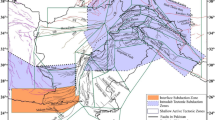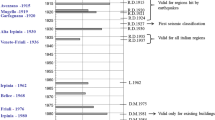Abstract
The occurrence of numerous earthquakes and the conducted geological research on the existing faults all prove that living in a seismically prone region. On the other hand, due to the lack of attention of the engineering community to save the construction, many buildings have been left in which the special preparations for earthquakes have not been considered. Since the gained experiences from past earthquakes show the high vulnerability of the masonry buildings, it is necessary to investigate the vulnerability of the existing masonry walls to identify the vulnerable points in the earthquakes and improve the seismic performance of the masonry buildings by a suitable solution. Taking into account the wide array of masonry building materials available worldwide, this article delves into an in-depth investigation of masonry buildings' seismic performance. It not only identifies their vulnerable points but also highlights potential points of rupture. Subsequently, we utilized ABAQUS software to create models and conduct a rigorous analysis of several masonry walls. The results of this study showed that the masonry walls could be rationally analyzed with suitable modeling by using the finite element method, and the behavior of the wall can be investigated under the applied loads.






























Similar content being viewed by others
Data availability
The authors do not have permissions to share data.
References
A. C. I. C. 523 (2009) Guide for Design and Construction with Autoclaved Aerated Concrete Panels. American Concrete Institute
A. C. I. C. 318 (1995) Building code requirements for structural concrete : (ACI 318–95); and commentary (ACI 318R-95). American Concrete Institute, Farmington Hills ©1995. [Online]. Available: https://search.library.wisc.edu/catalog/999777001402121
A. C307–18, “Standard test method for tensile strength of chemical-resistant mortar, grouts, and monolithic surfacings,” in American Society of Testing and Materials, 2018, pp. 1–4.
Abaqus V (1999) Documentation. Dassault Systemes Simulia Corporation. 2014. 6.14. 651: 6.2. Belytschko T. & Black T. Elastic crack growth in finite elements with minimal remeshing. Int J Numer Methods Eng 45(5):601–620
Avcil F, Izol R, Gürel MA, Arkan E, Mollamahmutoğlu Ç (2023) Efficiency of buttress form on the out-of-plane resistance of masonry walls subjected to vault thrust. Teh Vjesn 30(4):1039–1046
Brode HL (1955) Numerical solutions of spherical blast waves. J Appl Phys 26(6):766–775
Bui TT, Limam A (2014) Out-of-plane behaviour of hollow concrete block masonry walls unstrengthened and strengthened with CFRP composite. Compos Part B Eng 67:527–542
Casapulla C, Giresini L, Argiento LU, Maione A (2019) Nonlinear static and dynamic analysis of rocking masonry corners using rigid macro-block modeling. Int J Struct Stab Dyn 19(11):1950137
Chen L, Fang Q, Fan J, Zhang Y, Hao H, Liu J (2014) Responses of masonry infill walls retrofitted with CFRP, steel wire mesh and laminated bars to blast loadings. Adv Struct Eng 17(6):817–836
Cormie D, Mays G, Smith P (2009) Blast effects on buildings. Thomas Telford Publishing
Deyazada M, Vandoren B, Dragan D, Degée H (2019) Experimental investigations on the resistance of masonry walls with AAC thermal break layer. Constr Build Mater 224:474–492
D. of Defense (2008) Structures to resist the effects of accidental explosions. UFC 3–340–02.
Dogariu A, Campitiello F (2010) Calibration of a FE model of masonry shear panels strengthened by metal sheathing. In: Proceedings of the 3rd WSEAS International Conference on Finite Differences—Finite Elements—Finite Volumes—Boundary Elements, Citeseer
Esmaeilnia Omran M, Mollaei S (2017) Investigation of axial strengthened reinforced concrete columns under lateral blast loading. Shock Vib 2017:1–18
FatihAvcıl E (2022) Assessment of architectural heritage characteristics and seismic behavior of Ziyaeddin Han Tomb. Bitlis Eren Univ J Sci Technol 12(2):79–85
Hammond GP, Jones CI (2008) Embodied energy and carbon in construction materials. Proc Inst Civ Eng 161(2):87–98
Hao H, Wu C (2006) Numerical simulation of damage of low-rise RC frame structures with infilled masonry walls to explosive loads. Aust J Struct Eng 7(1):13–22
Hinman E (2023) Primer for design of commercial buildings to mitigate terrorist attacks. In: Risk Manag. Ser. FEMA. Fed. Emerg. Manag. Agency, Washington, DC
Işık E, Harirchian E, Arkan E, Avcil F, Günay M (2022a) Structural analysis of five historical minarets in Bitlis (Turkey). Buildings 12(2):159
Işık E, Avcil F, Harirchian E, Arkan E, Bilgin H, Özmen HB (2022b) Architectural characteristics and seismic vulnerability assessment of a historical masonry minaret under different seismic risks and probabilities of exceedance. Buildings 12(8):1200
Işık E et al (2023a) Structural damages in masonry buildings in Adıyaman during the Kahramanmaraş (Turkiye) earthquakes (Mw 7.7 and Mw 7.6) on 06 February 2023. Eng Fail Anal 151:107405. https://doi.org/10.1016/j.engfailanal.2023.107405
Işık E, Avcil F, Arkan E, Büyüksaraç A, İzol R, Topalan M (2023b) Structural damage evaluation of mosques and minarets in Adıyaman due to the 06 February 2023 Kahramanmaraş earthquakes. Eng Fail Anal 151:107345. https://doi.org/10.1016/j.engfailanal.2023.107345
Keys RA, Clubley SK (2017) Experimental analysis of debris distribution of masonry panels subjected to long duration blast loading. Eng Struct 130:229–241
Kocaman İ (2023) The effect of the Kahramanmaraş earthquakes (Mw 7.7 and Mw 7.6) on historical masonry mosques and minarets. Eng Fail Anal 149:107225. https://doi.org/10.1016/j.engfailanal.2023.107225
Kumar V, Kartik KV, Iqbal MA (2020) Experimental and numerical investigation of reinforced concrete slabs under blast loading. Eng Struct 206:110125
Li Z et al (2017) Study of autoclaved aerated concrete masonry walls under vented gas explosions. Eng Struct 141:444–460
Liu C, Hou J, Hao Y, Hao H, Meng X (2021) Effect of high strain rate and confinement on the compressive properties of autoclaved aerated concrete. Int J Impact Eng 156:103943
Mohamed ASO (2004) Behaviour of retrofitted masonry shear walls subjected to cycling loading. Inst. für Massivbau und Baustofftechnologie
Mollaei S, Babaei M, JalilKhani M (2021) Assessment of damage and residual load capacity of the normal and retrofitted RC columns against the impact loading. J Rehabil Civ Eng 9(1):29–51
Mollaei S, Babaei Ghazijahani R, Noroozinejad Farsangi E, Jahani D (2022) Investigation of behavior of masonry walls constructed with autoclaved aerated concrete blocks under blast loading. Appl Sci 12(17):8725
Momeni M, Hadianfard MA, Bedon C, Baghlani A (2019) Numerical damage evaluation assessment of blast loaded steel columns with similar section properties. Struct Elsevier, pp. 189–203.
Momeni M, Hadianfard MA, Bedon C, Baghlani A (2020) Damage evaluation of H-section steel columns under impulsive blast loads via gene expression programming. Eng Struct 219:110909
Pantò B, Casapulla C, Caliò I (2021) Discrete rotating links model for the non-linear torsion−shear behaviour of masonry joints. Proc Inst Civ Eng Comput Mech 174(4):215–235
Papanicolaou C, Triantafillou T, Lekka M (2011) Externally bonded grids as strengthening and seismic retrofitting materials of masonry panels. Constr Build Mater 25(2):504–514
Preciado A, Ramírez-Gaytán A, Salido-Ruiz R, Caro-Becerra JL, Lujan-Godinez R (2015) Earthquake risk assessment methods of unreinforced masonry structures: Hazard and vulnerability
Sassu M, Andreini M, Casapulla C, De Falco A (2013) Archaeological consolidation of UNESCO masonry structures in Oman: the Sumhuram Citadel of Khor Rori and the Al Balid Fortress. Int J Archit Herit 7(4):339–374
Sovják R, Koutný O, Hála P (2021) Penetration resistance of building materials against 7.62-mm armor-piercing projectile. J Mater Civ Eng 33(9):4021224
Stepinac M, Kisicek T, Renić T, Hafner I, Bedon C (2020) Methods for the assessment of critical properties in existing masonry structures under seismic loads—the ARES project. Appl Sci 10(5):1576
Tanner JE, Varela JL, Klingner RE, Brightman MJ, Cancino U (2005a) Seismic testing of autoclaved aerated concrete shearwalls: a comprehensive review. ACI Struct J 102(3):374
Tanner JE, Varela JL, Klingner RE (2005b) Design and seismic testing of two-story, full-scale autoclaved aerated concrete assemblage specimen. ACI Struct J 102(1):114
Tomaževič M, Gams M (2012) Shaking table study and modelling of seismic behaviour of confined AAC masonry buildings. Bull Earthq Eng 10:863–893
Uddin N, Shelar KV, Fouad F (2006) Impact response of autoclave aerated concrete/FRP sandwich structures. Structures Congress. Struct Eng Public Saf 2006:1–10
Winkels B, Nebel H, Raupach M (2018) Carbonation of autoclaved aerated concrete containing fly ash. Ce/papers 2(4):47–51
Wu C, Hao H (2007) Safe scaled distance for masonry infilled RC frame structures subjected to airblast loads. J Perform Constr Facil 21(6):422–431
Xu WX, Bao Q, Li Z, Fan JY (2015) Numerical analysis on the behavior of autoclaved aerated concrete block infilled wall subjected to gas explosion. Appl Mech Mater 723:259–265
Yankelevsky DZ, Avnon I (1998) Autoclaved aerated concrete behavior under explosive action. Constr Build Mater 12(6–7):359–364
Zucchini A, Lourenço PB (2002) A micro-mechanical model for the homogenisation of masonry. Int J Solids Struct 39(12):3233–3255
Author information
Authors and Affiliations
Contributions
PM: writing-original draft preparation, conceptualization, supervision, project administration.
Corresponding author
Ethics declarations
Conflict of interest
The authors declare that there are no competing interests.
Additional information
Publisher's Note
Springer Nature remains neutral with regard to jurisdictional claims in published maps and institutional affiliations.
Rights and permissions
Springer Nature or its licensor (e.g. a society or other partner) holds exclusive rights to this article under a publishing agreement with the author(s) or other rightsholder(s); author self-archiving of the accepted manuscript version of this article is solely governed by the terms of such publishing agreement and applicable law.
About this article
Cite this article
Ma, P. Analyzing seismic behavior and micro-modeling of masonry walls using ABAQUS software. Multiscale and Multidiscip. Model. Exp. and Des. (2024). https://doi.org/10.1007/s41939-023-00344-9
Received:
Accepted:
Published:
DOI: https://doi.org/10.1007/s41939-023-00344-9




